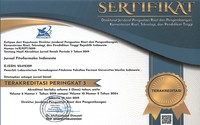EFEK SENYAWA BIOAKTIF KAYU MANIS Cinnamomum burmanii NEES EX.BL.) TERHADAP DIABETES MELITUS: KAJIAN PUSTAKA
Abstract
Diabetes Mellitus (DM) is a chronic disorder of carbohydrate metabolism (glucose) in the body and its prevalence is getting higher. Until 2015, 10 million cases of DM found in Indonesia and allegedly ever increasing. Type II DM is the most common types of DM in the world and its characterized by insulin resistance and β cell damage. Due to the serious side effects caused when taking chemical antidabetes drugs, herbal medicine searches from natural materials continue to be done. Various spesieces of cinnamon plants have been studied and known to have antidiabetic activity. One of them is Cinnamomum burmanii which is found in Indonesia. Among the spesieces of cinnamon have the same health benefits including antidiabetes, antimicrobial, anti-fungal, antiviral, antioxidant, antitumor etc. Although the antidiabetic mechanism of cinnamon is still debated, it is thought that cinnamon affects several insulin signaling pathways, among others, in insulin receptors, glucose transporter 4 (GLUT 4), glucose transporter-1 (GLUT 1), peroxisome proliferator activator receptor (PPAR), α activity glucosidase etc. This activity is caused of the bioactive compounds it contains. The main compounds that have hypoglycemic activity are Methylhidroxy Calcone Polymer (MHCP), sinamaldehyde, and polymer pro-ayanine type-A polymers or proanthocyanidin.
Full Text:
PDF (Bahasa Indonesia)DOI: https://doi.org/10.33096/jffi.v5i1.316
Copyright (c) 2018 Jurnal Fitofarmaka Indonesia
Indexed by:
ISSN: 2356-0398 | e-ISSN: 2541-2329
Editor's Address:
Third Floor Pharmacognosy-phytochemistry laboratory building, Urip Sumoharjo road km. 5 Campus II UMI, Makassar, South Sulawesi, Indonesia
Phone: +6281524045514
Fax: +62411425619
E-mail: editorjfi@umi.ac.id

















.jpg)

